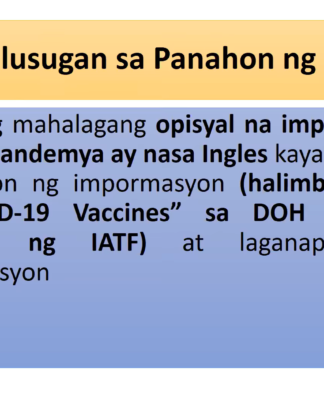 FROM your morning coffee to the can of softdrinks during lunch and the cup of ice cream for dessert— there’s no avoiding sugar. However, due to some dietary problems such as diabetes and obesity, some people resort to chemically modified alternatives—artificial sweeteners in the form of aspartame.
FROM your morning coffee to the can of softdrinks during lunch and the cup of ice cream for dessert— there’s no avoiding sugar. However, due to some dietary problems such as diabetes and obesity, some people resort to chemically modified alternatives—artificial sweeteners in the form of aspartame.
Recent studies, however, show that these food substitutes have yielded several adverse effects among its consumers. Will this scenario signal the ending of the sweet sensations over artificial sweeteners?
According to GreenFacts, a Belgian non-profit organization which summarizes complex scientific reports on health and environment for the public, aspartame, chemically known as L-aspartyl-L-phenylalanine methyl ester, is a low-calorie artificial sweetener used to replace sugar and to control weight.
Aspartame, which is found in tabletop artificial sweeteners such as Equal and Nutrasweet, and diet softdrinks with zero-sugar tags, is one of several artificial sweeteners approved by the United States Food and Drug Administration (FDA) that are available in the market nowadays along with saccharin, cyclamate, alitame, neotame, acesulfame-K, and sucralose.
According to Dr. Anita Sangalang, a pharmacology professor from the Faculty of Pharmacy, aspartame was accidentally discovered by scientists testing an anti-ulcer drug. The sweetness of aspartame led them to consider it as a possible sugar substitute.
According to the FDA, aspartame is 200 times sweeter than sugar, with a caloric value similar to sugar (four kilocalories per gram), but a sufficiently low amount of aspartame is used to produce a sweet taste, so the caloric value produced is also low.
Because of its low caloric value, aspartame reduces the risk of increased blood sugar levels, which triggers the production of insulin, a hormone secreted by the beta cells of the pancreas to decrease blood sugar levels. Since diabetics have a deficiency or malfunction in insulin production, aspartame serves as a viable alternative to sugar.
Bitter aftertaste
Aspartame is manufactured by combining phenylalanine and aspartic acid linked by methanol, commonly known as wood alcohol. Phenylalanine and Aspartic acid are two classes of amino acids which are defined as the building blocks of protein. These amino acids are not substantially tolerated by the body because of their toxicity, which may lead to increased blood pressure, allergic reactions, and nerve damage.
According to Sangalang, when aspartame is taken up by the body, it is broken down by the gastrointestinal tract into degradation products. Methanol is readily absorbed and distributed to the tissues. It is then metabolized to formaldehyde and formic acid, which accumulate inside the cells. Formaldehyde is a substance considered as the main component of formalin, a chemical primarily used to preserve human remains.
“When formaldehyde accumulates in the body, especially in the brain, it may cause severe central nervous system damage brought about by the development of tumors and reduction of neurotransmitter functions which may lead to a brain breakdown,” she said.
In a 1996 article published in the Journal of Neuropathology and Experimental Neurology, Dr. John Olney, professor of psychiatry, pathology, and immunology at the Washington University School of Medicine, reports that the high consumption of aspartame may pose risks to human health. A large number of unfavorable risks have been attributed to aspartame such as brain tumors, epileptic seizures, multiple sclerosis wherein the immune system attacks the central nervous system, lupus erythematosus, a systemic autoimmune disease in which the immune system attacks the body’s cells and tissues.
Other listed overconsumption risks of aspartame, according to the United States Health and Human Services report are irreversible brain damage, mental retardation, mimicry of several chronic illnesses such as Alzheimer’s disease, certain leukemias, blindness, decreased vision, ringing of ears, and dizziness.
Sweeter side
Meanwhile, to lessen the possible adverse effects of these substances to people, the European Commission’s Scientific Committee on Food and the United Nations/World Health Organization Expert Committee on Food Additives’ Joint Food and Agriculture Organization (JECFA) made use of aspartame’s toxicity data to establish an Acceptable Daily Intake (ADI). ADI represents a daily intake level of food additives, including aspartame, which is to be maintained throughout a person’s lifetime.
JECFA, on one hand, has established a value of 40 milligrams per kilogram (mg/kg) body weight per day for the Europeans and Canadians. The FDA, on the other hand, established an ADI of 50 mg/kg body weight per day for the Americans, which is about 18 to 19 12-ounce cans of diet cola for a 150-pound (70 kg) person.
But despite the possible risks of acquiring dreadful diseases through intake of artificial sweeteners, the United States National Cancer Institute claims that there is no current scientific evidence that any of the approved artificial sweeteners cause cancer in the United States, and that studies also confirm that artificial sweeteners are safe for the general population.
According to Andrea Vargas, instructor of biochemistry at the Faculty of Pharmacy, phenylalanine, one of the amino acid compositions of aspartame, is only toxic in excessive amounts. “As an amino acid, it is needed by the body for protein synthesis. But above normal limits, it will have to be eliminated by the body because we don’t store them.”
Also, Sangalang said that if taken in prescribed amounts, aspartame can be taken, especially by diabetics. But she also said that if possible, it is better to go natural.
“If we can avoid taking up artificial sweeteners or sugars for diabetics, then why bother risking your health? It is better to be fit and take natural foods to prevent health problems,” said Sangalang.
















